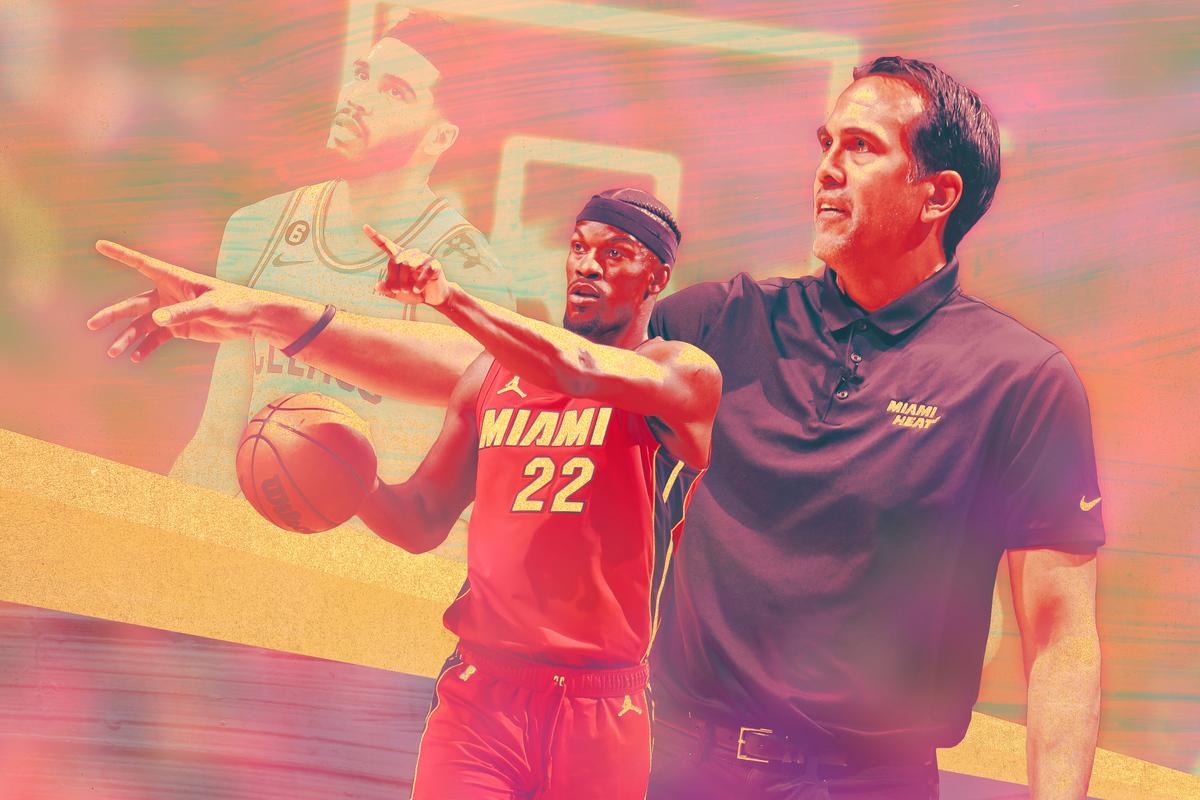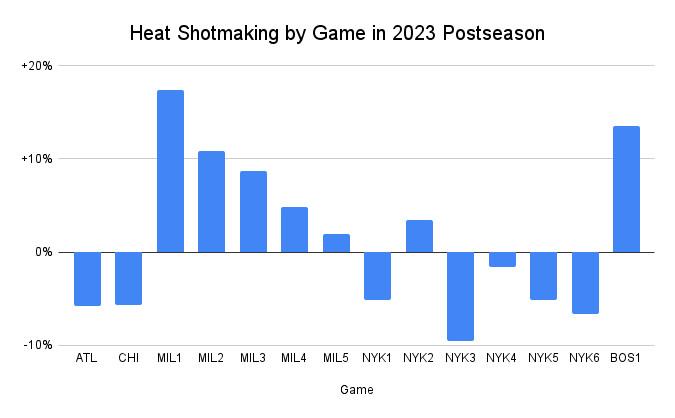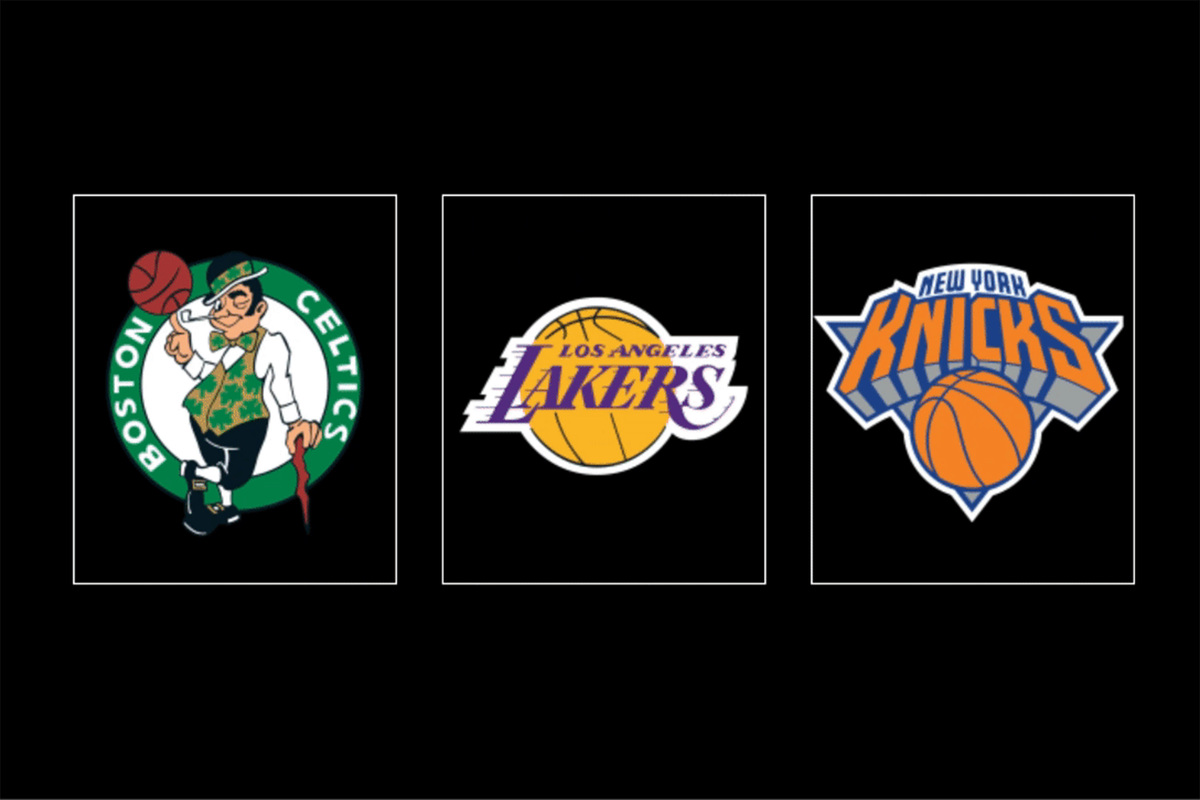How Do the Heat Keep Doing This?
Miami’s unlikely transformation into a postseason juggernaut continued apace in Game 1 in Boston. And while the Celtics may find solace in the fact that torrid shooting is difficult to repeat, when it comes to Jimmy Butler and the Heat, it sure feels like anything is possible.
Have the Miami Heat devoured magic beans? Do they consume a nightly dose of Michael’s Secret Stuff? Did Pat Riley and Erik Spoelstra make a dastardly deal with the devil?
Earthly explanations don’t suffice; something supernatural must be at play. How else can NBA viewers fathom what’s happened to Miami this postseason?
The Heat were outscored in the regular season. They are the no. 8 seed in the Eastern playoff bracket. They lost their first play-in game to the Hawks, then were fewer than three minutes away from elimination against the Bulls in their second play-in contest. And yet, a month later, Miami now leads the Eastern Conference finals after stealing Game 1 in Boston, 123-116.
The most gobsmacking element of the Heat’s gobsmacking run—featuring upsets over the Knicks and the championship favorite Bucks, and now their third series-opening road win of the postseason—is their sudden transformation into an offensive juggernaut. Consider the following comparisons:
In the regular season, the Heat ranked 25th in the NBA in offensive rating—ahead of only five lottery teams. They scored 112 points per 100 possessions. But in Game 1 against Boston—which ranked second in the league in defensive rating—the Heat scored a franchise playoff-record 46 points in the third quarter and finished with an overall rate of 126.8 points per 100 possessions.
The Heat made just 34 percent of their 3-point attempts in the regular season, which ranked 27th. (And their best shooter was Tyler Herro, who’s since missed nearly the entire postseason with a broken hand.) In Game 1 against Boston, they made 52 percent of their 3s (16 of 31).
The Heat made 42 percent of their long midrange shots in the regular season, per Cleaning the Glass—exactly the league-average rate from that distance. In Game 1 against Boston, they made 64 percent (9 of 14).
Overall, Miami’s expected effective field goal percentage against Boston—accounting for factors like shot location, defender distance, and shooter identity—was 50 percent, according to Second Spectrum. But Miami’s actual eFG% was a whopping 64 percent. The Celtics had much better shot quality than the Heat in Game 1, but the visitors crushed in shotmaking.
Heat Vs. Celtics Game 1
Miami’s overperformance of nearly 14 percentage points is the fourth largest for any team in any game in these playoffs—but it’s nothing new for the Heat this postseason. Three of this postseason’s top five overperformances by this metric now belong to them, with their Game 1 showing against the Bucks taking the top spot:
Best Shotmaking Games of 2023 Postseason
Granted, Miami hasn’t scorched the net throughout its entire postseason run thus far. The Heat suffered subpar shotmaking in both play-in games and most of their second-round victory against the Knicks.

But when they’re on, evidently, they’re really on—at both a team and individual level. Six different Heat players made multiple 3s against Boston on Wednesday, and none of them were better than league-average shooters from distance in the regular season.
Heat 3-Point Shooters
Yet somehow, the entire team has caught fire for extended stretches this spring. So-called Heat culture typically refers to work ethic and hustle and a penchant for taking charges and diving for loose balls—but now it evidently includes turning every player on the roster, from Jimmy Butler to undrafted players to a waiver-wire pickup in Kevin Love, into Kevin Durant from the perimeter.
Butler was the star again in Game 1, with a final stat line of 35 points, seven assists, six steals (!), and five rebounds. And in a fitting tribute to Miami’s team-wide hot streak, his final made shot of the night—a pull-up four bouncer from well behind the line with a hand in his face—was the team’s most unlikely made 3 in the game, according to Second Spectrum.
The Heat’s depth beyond Butler was also critical in powering them to the road victory. Kyle Lowry, Caleb Martin, Max Strus, and Gabe Vincent all scored exactly 15 points apiece, and Lowry in particular provided crucial ballast off the bench when Boston threatened to build a big lead in the first half.
The Celtics controlled the game early, with their deep cast of perimeter creators getting to the rim at will. Marcus Smart enjoyed the most effective passing half of his career as he collected 10 assists by halftime—many of them worthy of a highlight reel.
But in the second half, the Celtics stumbled at home, as they have so often in the last two playoffs. Boston’s biggest 2022 bugaboo returned in Game 1, as the home team committed careless turnovers in key spots and finished with 15 giveaways in the game. Jayson Tatum and Jaylen Brown were responsible for 10 of them, and during one five-possession span late in the fourth quarter, Boston ended four trips with turnovers.
Boston also squandered too many trips to the free throw line—even Malcolm Brogdon, a career 88 percent free throw shooter, missed a pair—and veered too far away from its aggressive rim attacks after halftime. The Celtics scored 40 points in the paint in the first half, but just 22 in the second half.
Cleaning up those basic mistakes should help the Celtics rally in Game 2 and beyond. So could tweaking the substitution patterns. Coach Joe Mazzulla’s surprise insertion of Payton Pritchard into the rotation didn’t work, as the reserve guard didn’t score a point in 12 minutes of action. And while Robert Williams III remained in the starting lineup against Miami after his inclusion turned around the Celtics’ series against the 76ers, the Heat looked more comfortable when Boston played two bigs instead of spreading out with four guards and wings at a time. Williams posted impressive individual numbers in Game 1—14 points on 6-for-6 shooting, plus four offensive rebounds—but Boston was outscored by 14 points when Time Lord was in the game, the worst mark for any Celtic.
Just a game in, of course, this series is far from over. The Celtics lost Game 1 against Philadelphia just last round before coming back to advance; ditto in last year’s conference finals, when they eventually took down the Heat in seven games.
And winning the shot quality battle by such a large gap in Game 1 should be a comforting sign for Boston, given that outliers in shotmaking happen in a make-or-miss league but aren’t necessarily repeatable.
There have been 10 other series in the past five postseasons in which the higher seed lost Game 1 because of a shotmaking gap of at least 10 percentage points, according to an analysis of Second Spectrum data. Eight of those 10 higher seeds still went on to win the series, despite losing Game 1—and the most common outcome saw the higher seed subsequently win four games in a row:
- The 76ers beat the Nets in five games in 2019.
- The Bucks beat the Celtics in five games in 2019.
- The Bucks beat the Magic in five games in 2020.
- The Lakers beat the Trail Blazers in five games in 2020.
- The Raptors lost to the Celtics in seven games in 2020.
- The Lakers beat the Rockets in five games in 2020.
- The Clippers beat the Mavericks in seven games in 2021.
- The Bucks beat the Hawks in six games in 2021.
- The Grizzlies beat the Timberwolves in six games in 2022.
- The Bucks lost to the Heat in five games in 2023.
But as the last line in that list shows, one of the two higher seeds that went on to lose in this scenario was the Bucks, against these very Heat, just last month.
In other words, the Celtics would probably be encouraged by their standing after Game 1 against any other team in the league. But not, perhaps, against these Heat. The first step to solve a problem is to identify its cause, and as long as the source of Miami’s shooting magic remains a mystery, there’s no telling whether the Celtics can contain it sufficiently to return to the Finals.


